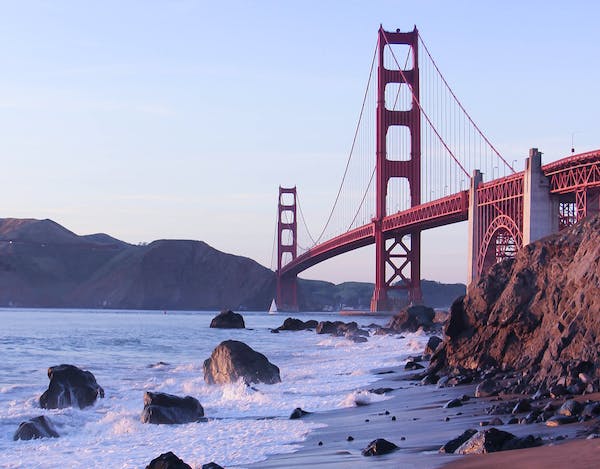7. Skyline Ridge Trail
Difficulty: Advanced. Duration: 6 - 8 hours return. Distance: 24 km return. Elevation Gain: 700 meters. Seasonality: Summer
The Skyline Ridge Trail is a hiking trail located in various locations in the United States and Canada. In Olympic National Park, the Skyline Ridge Primitive Trail is a challenging 54.5-mile trail near Quinault, Washington.
The pass becomes narrower and steeper as it continues north, following the ridgeline toward the Kimta Peak Basin.
In Nova Scotia, the Skyline Trail is a hiking path that leads up a steep headland cliff overlooking the Gulf of St. Lawrence and the Atlantic Ocean. It's breathtaking and includes the Cabot Trail, Presqueville and Cheticamp Islands
In the Bay Area, the Skyline Ridge and Russian Ridge Open Space Preserves offer hikes through open grasslands to high ridges with gradual elevation gain and loss. The route consists of narrow hiking trails and wide farm roads over marshy land.
Tips
Skyline Ridge Open Space Preserve and Skyline Loop Trail are popular hiking destinations, offering beautiful views and diverse landscapes. Here are some tips for hiking these trails.
Skyline Ridge Open Space Preserve:
Located in California, this preserve offers various trails, with the best one being Horseshoe Lake - Alpine Pond - Borel
The trail is open to hikers only and begins in grassland before entering a woodland of Douglas fir, coast live oak, and big-leaf maple.
Skyline Loop Trail at Mount Rainier:
This trail is located in Mount Rainier National Park and offers a 5.5-mile loop with an elevation gain of 1,700 feet
The trailhead is located at the Paradise parking lot in Mount Rainier National Park
The trail is considered moderate to hard in difficulty and is not dog-friendly
To reach the trailhead, you need to take the Paradise Shuttle or Longmire Shuttle from the Paradise parking lot
The trail offers incredible views of the south and is a popular choice among hikers
Skyline Ridge Primitive Trail in Olympic National Park:
This trail is located in Olympic National Park and features rock cairns to aid in navigation through the alpine area
The trail is a 1-mile loop with bear canisters required for food storage due to the lack of good trees for hanging food
Camp in established sites or on bare ground, and practice Leave No Trace principles to protect vegetation and other park resources
When planning your hike, consider the season, difficulty, and trailhead location to ensure a safe and enjoyable experience. Always follow Leave No Trace principles and stay on designated trails to protect the environment and local wildlife.
9. Ozette Triangle Loop Trail
Difficulty: Advanced | Duration: 6 - 8 hours | Lenth: 9.4 Miles Roundup | Elevation Gain 100 Fit | Highest Point: 350 Fit
Ozette Triangle Loop Trail
The Ozette Triangle Loop Trail, also known as the Cape Alava Loop, is a 9.4-mile loop trail located in Olympic National Park, Washington. It offers a combination of a forest stroll and a walk on the beach, making it a diverse and scenic hiking experience. The trail starts at Lake Ozette, the largest unaltered natural lake in Washington, and includes a section along the coast where hikers can enjoy sea lion sightings, otter frolics, and eagle watching. The trail is generally considered moderately challenging and is a popular choice for hikers and backpackers looking to explore the natural beauty of the area
For more detailed information about the trail, including maps, camping permits, and trail conditions, hikers are advised to visit the official Olympic National Park website and the Washington Trails Association website. Additionally, it is recommended to check the trail conditions and read trip reports before embarking on the hike
Ozette Triangle Loop Trail for Tips
The Ozette Triangle Loop Trail is a hike in Olympic National Park that offers a combination of forest strolls and beach walks
The trail is 9.4 miles long and can be hiked in a single day, but it can also be enjoyed as a multi-day backpacking trip
Some key aspects of the Trial include:
Trailhead: The trailhead is located at Lake Ozette, which is the largest unaltered natural lake in Washington
Cape Alava Trail: The hike starts with the Cape Alava Trail, which takes you out to the beach and back for a 6.2-mile hike
Sand Point Trail: To make the loop longer (9.4 miles), you can continue south along the beach and connect with the Sand Point Trail
Camping: The trail offers great camp spots strategically located along the coastline, making it suitable for multi-day hikes
Seasonality: The trail is accessible all year round, unlike many other trails in Washington State that are covered in snow during winter
Before embarking on the hike, it is essential to check the trail conditions on the Olympic National Park website and read trip reports on the Washington Trails Association website
There is no public transportation to the trailhead, so you will need to drive yourself
It is also crucial to be aware of potential encounters with wildlife, such as mountain lions, especially during the night.
10. High Divide Trail & the Seven Lakes Basin Loop
Difficulty: Advanced | Duration: 6 - 8 hours | Lenth: 19.0 Miles Roundtrip | Elevation Gain 4,000 Fit | Highest Point: 5,120 Fit.

The High Divide Trail and the Seven Lakes Basin Loop are located in Olympic National Park and offer a stunning 19-mile round-trip hike with about 4,000 feet of elevation gain
The trail takes you through four ecosystems: old-growth forest, subalpine meadow, subalpine lake basin, and montane forest
Some key features of the trail include:
Seven Lakes Basin: A formerly-glaciated mountain lake basin at the headwaters of the Sol Duc River
There are eight small lakes and numerous tiny ponds in the area, including Sol Duc, Long, Lunch, Morgenroth, No Name, Clear, Round, and Lake No.
High Divide Loop: A 19-mile loop trail that starts by following the Sol Duc River near Sol Duc Hot Springs, traverses south past Sol Duc Falls and then begins a rapid elevation gain to arrive at the basin
The loop trail offers views across the Hoh Valley to Mt. Olympus to the south
Wildlife: The area is home to various wildlife, such as black bears, marmots, black-tailed deer, mountain goats, and small brook trout
Camping: Camping is limited and requires reservations up to 6 months in advance via Recreation.gov
There are several campgrounds and campsites along the trail, with the most sought-after sites being Heart Lake and Lunch Lake
Difficulty: The trail is generally considered moderate in difficulty, with an elevation gain of 3,050 feet
The High Divide Loop and Seven Lakes Basin offer a diverse and picturesque hiking experience, making it a popular destination for backpackers and nature lovers alike.
High Divide Trail & the Seven Lakes Basin Loop For Tips
The High Divide Trail, also known as the Seven Lakes Basin Trail, is a popular backpacking route in Washington, offering a diverse range of landscapes and stunning views. The trail is approximately 18.3 miles long and gains 3,050 feet in elevation, with a difficulty level rated as moderate
To make the most of your experience, consider the following tips:
Best time to go: The best time to hike the High Divide Trail is from mid-July to mid-October. May, June, and the beginning of July may have a chance of snow, while September and October are great for spotting fall colors, although the weather might be less predictable
Permits: Due to the trail's popularity, a permit is required for overnight stays. You do not need a permit for day hiking
Water: There is no water between Heart Lake and Lunch Lake in the early summer. By the time most hikers reach this section, the snow has usually melted, but you should still fill up all your water reservoirs before starting the trail
Weather: Be prepared for a variety of weather conditions, as the trail passes through four ecosystems: old-growth forest, subalpine meadow, subalpine lake basin, and montane forest
Views: The trail offers breathtaking views of the Seven Lakes Basin, Mount Olympus, and other stunning landscapes. Take your time to soak in the scenery and enjoy the tranquility of the area
Side trips: Consider taking side trips to Lunch Lake or Bogachiel Peak along the way for additional views and experiences
Camping: There are several private spots along the trail for camping, but they can be crowded. Plan your camping locations in advance and consider alternative options if your preferred spot is taken
Remember to follow Leave No Trace principles and respect the natural environment when hiking the High Divide Trail and Seven Lakes Basin Loop.


.jpg)

























